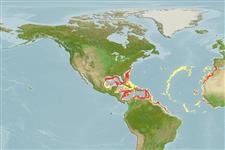Teleostei (teleosts) >
Gadiformes (Cods) >
Macrouridae (Grenadiers or rattails)
Etymology: Coryphaenoides: Greek, koryphaina = dolphin fish + Suffix oides = similar to (Ref. 45335).
More on author: Vaillant.
Environment: milieu / climate zone / depth range / distribution range
Ecology
Marine; bathydemersal; non-migratory; depth range 400 - 2375 m (Ref. 3587). Deep-water; 37°N - 0°N, 98°W - 4°W (Ref. 1371)
Central Atlantic: Western Central Atlantic: off Chesapeake Bay, Gulf of Mexico, and the Caribbean. Eastern Central Atlantic: Mauritania to Côte d'Ivoire.
Size / Weight / Age
Maturity: Lm ? range ? - ? cm
Max length : 40.0 cm TL male/unsexed; (Ref. 1371)
Dorsal spines (total): 2; Anal spines: 0. Head large, completely scaled, including the ventral surfaces of the snout; snout short, narrow, with stout scutes at its tip and lateral angles; mouth small, restricted laterally. Scales with numerous (over 100 in large specimens) short, stout spinules arranged in V-shaped rows. Pyloric caeca short, 10 to 15. Overall color is medium to dark brown; fins generally blackish.
Body shape (shape guide): elongated; Cross section: circular.
Feeds primarily on benthic organisms, especially gammarian amphipods and, to a lesser extent, lamellibranchs, copepods, polychaetes, ostracods, isopods mysids, Natantia, and echinoderms (Ref. 1371). Minimum depth record from Ref. 1371.
Life cycle and mating behavior
Maturity | Reproduction | Spawning | Eggs | Fecundity | Larvae
Cohen, D.M., T. Inada, T. Iwamoto and N. Scialabba, 1990. FAO species catalogue. Vol. 10. Gadiform fishes of the world (Order Gadiformes). An annotated and illustrated catalogue of cods, hakes, grenadiers and other gadiform fishes known to date. FAO Fish. Synop. 125(10). Rome: FAO. 442 p. (Ref. 1371)
IUCN Red List Status (Ref. 130435: Version 2025-1)
Threat to humans
Harmless
Human uses
Fisheries: of no interest
Tools
Special reports
Download XML
Internet sources
Estimates based on models
Preferred temperature (Ref.
123201): 4.6 - 10, mean 6.2 °C (based on 211 cells).
Phylogenetic diversity index (Ref.
82804): PD
50 = 0.5000 [Uniqueness, from 0.5 = low to 2.0 = high].
Bayesian length-weight: a=0.00214 (0.00109 - 0.00421), b=3.20 (3.03 - 3.37), in cm total length, based on LWR estimates for this (Sub)family-body shape (Ref.
93245).
Trophic level (Ref.
69278): 3.2 ±0.37 se; based on food items.
Resilience (Ref.
120179): Low, minimum population doubling time 4.5 - 14 years (Preliminary K or Fecundity.).
Fishing Vulnerability (Ref.
59153): Low to moderate vulnerability (30 of 100).
🛈
